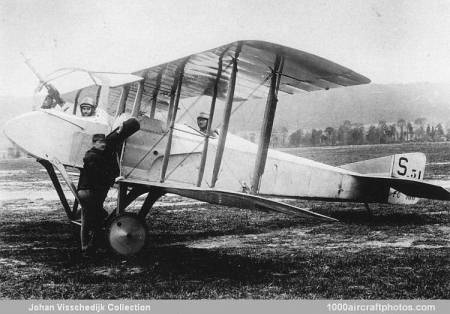The first fighter designed by Bechereau for the new SPAD organisation, the SA.1 was of somewhat bizarre concept, attempting to offer effective forward-firing armament while retaining a tractor engine arrangement. Powered by an 80 hp Le Rhône rotary engine and first flown on May 21, 1915, the SA.1 was of so-called "pulpit" type in that the observer/gunner occupied a small plywood nacelle ahead of the propeller.
A two-seat unstaggered equal-span single-bay biplane, with auxiliary intermediate struts stiffening the points of intersection of the flying and landing cables and giving the superficial impression of a two-bay arrangement, the SA.1 was of fabric covered wood and wire construction. The armament consisted of a single 0.303 in (7.7 mm) Lewis gun with limited traverse and elevation mounted in the forward nacelle, which was supported by two V-struts pivoted to the landing gear struts and secured to the propeller hub by an extension of the propeller shaft revolving in a ball-race attached to the rear of the nacelle. The entire nacelle had to be swung downwards to provide access to the engine.
Very limited production (possibly fewer than a half-dozen) of the SA.1 was undertaken for the Aviation Militaire before, by November 1915, it gave place to the SA.2, which differed essentially in having a 110 hp Le Rhône 9J engine, modified nacelle attachments and gun mount, and a revised horizontal tail with parallel leading and trailing edges. The 0.303 in (7.7 mm) Lewis gun was provided with an unusual mounting, being suspended between two curved vertical steel tubes hinged at their top to a vertical pylon and rotating at their base through some 180°, thus providing both elevation and traverse.
SPAD apparently received contracts for 100 SA.2 two-seat fighters, of which 57 were supplied to the Russian Imperial Air Service and at least one was completed as an SA.3. The remainder were supplied to the Aviation Militaire, but these saw relatively limited use at the Front, where, on February 1, 1916, only four SA.2s were with operational units, a further five being recorded with (presumably) training elements. Neither SA.1 nor its successor SA.2 proved popular with the aircrews, the observer/gunner inevitably being crushed by the engine in the event of the aircraft nosing over.
|
|
SA.1 |
SA.2 |
